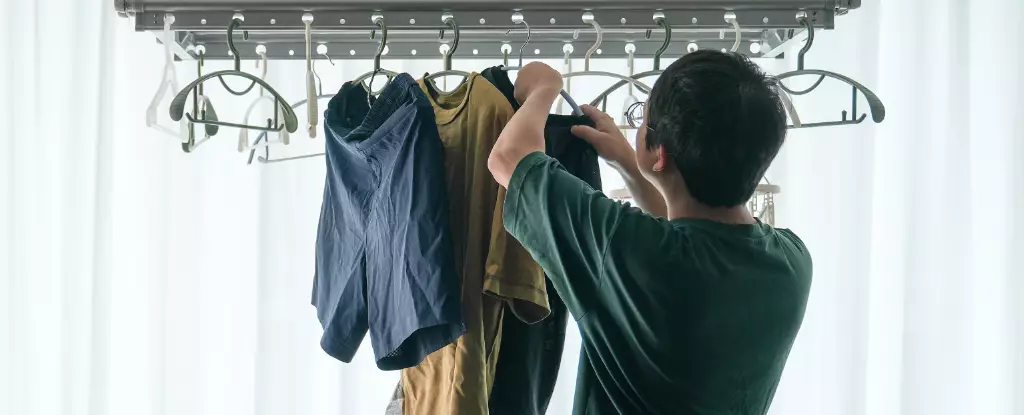In recent months, the incessant winter storms have wreaked havoc, leading to plummeting temperatures and gales reaching up to 100 mph. This has rendered the once-familiar sight of clothes fluttering in the breeze a rarity. As we are forced to adapt, drying methods have shifted largely indoors, sparking an essential conversation around the effects of such practices on our home environments and health. While it may seem innocuous to dry clothes on a rack in the comfort of our living spaces, the implications run deeper than mere convenience.
One glaring concern with indoor drying is the rise of mold, a pervasive threat that discreetly infiltrates our homes when conditions are ripe. Damp, poorly ventilated areas become breeding grounds for mold, leading to unsightly patches that not only mar the aesthetics of walls with their unsightly black or green hues but also emit a musty odor that is hard to ignore. The danger of mold should not be trivialized; prolonged exposure can usher in severe health ramifications, including respiratory ailments and, in extreme cases, death.
Mold is a broad term encompassing various fungi, which release spores under optimal growth conditions. These spores become airborne and can easily infiltrate indoor spaces, particularly where moisture lingers—like in bathrooms and inadequately aired rooms. The presence of mold is most often associated with a nonchalant approach to dampness in the home, making this a critical issue that homeowners need to address promptly.
Initial exposure to mold spores generally does not concern healthy individuals, thanks to the body’s immune defense system, which includes macrophages that target and eliminate these invasive spores. Yet, for a considerable portion of the population with weakened immune systems or pre-existing respiratory conditions, exposure to mold poses a severe risk.
Specific molds, such as Penicillium and Aspergillus, introduce an additional layer of concern as they can trigger asthma attacks and other respiratory problems. For asthma sufferers, inhaling mold spores can exacerbate inflammation in the lungs, hindering their ability to breathe comfortably. It’s a perilous cycle where the immune response to an allergen leads to worsening health outcomes, highlighting the need for a proactive approach in managing indoor air quality.
Mold’s insidious nature doesn’t stop at health implications; it extends to the development of antifungal resistance. Medical professionals often rely on antifungal treatments, such as azoles, to combat invasive mold infections. Unfortunately, emerging evidence suggests that mold species are developing resistance to these common drugs, limiting treatment options for affected individuals.
Compounding the problem, resistance is increasingly becoming an environmental issue rather than solely a clinical one. The use of antifungal agents in agriculture plays a crucial role in this development; the same compounds that combat plant mold are inadvertently conditioning mold species to withstand pharmacological intervention. Furthermore, climate change may exacerbate this issue, as extreme temperature fluctuations can encourage resistance in fungi, affecting their capacity to cause human illness.
The dangers of mold exposure became tragically evident in the case of Awaab Ishak, a toddler whose life was cut short due to unmanageable mold exposure in his home. This sent shockwaves through communities, leading to the introduction of Awaab’s Law in the UK, mandating landlords to address dampness in rental properties promptly. This legislative change reflects the urgent need for action to safeguard tenants and ensure that adverse living conditions do not lead to untimely casualties.
Keeping one’s home mold-free is imperative, and it can be achieved through diligent housekeeping and preventive measures. Adequate ventilation is paramount; every room should promote airflow to displace moisture. Dehumidifiers can be a valuable ally in this battle, especially in damp climates or during seasons like winter when indoor drying becomes a necessity. Alternatively, investing in electric heated clothes drying racks could reduce humidity levels in enclosed spaces while safely drying garments efficiently.
As we navigate the challenges of contemporary living—especially as the seasons change and weather patterns become more extreme—raising awareness about the hidden dangers of indoor drying practices is vital. Tackling the issue of mold not only protects individual health but also strengthens communal resilience against this growing threat. The focus on proactive measures must become a priority, ensuring that we take the necessary steps to uphold the integrity of our home environments for ourselves and for future generations.


Leave a Reply